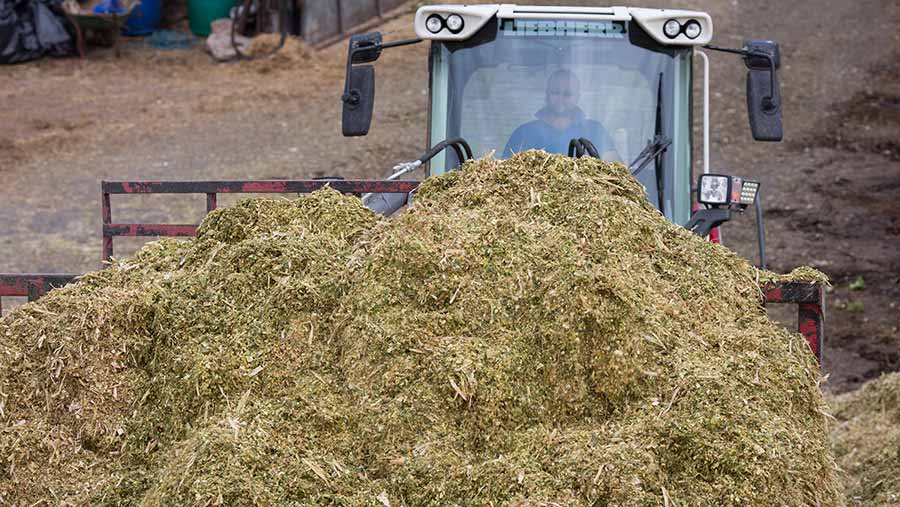Advice for managing forage supplies in a drought
 © Tim Scrivener
© Tim Scrivener Farmers are heading for a prolonged drought and forage supplies are drying up.
The most important objective in a prolonged summer drought after a long winter is to secure additional supplies of home- or locally-grown forage, or bulky forage replacements.
Mike Wilkinson, a nutritionist at the Maize Growers Association, discusses the possible options for securing more forage for the winter and spring.
1. Is irrigation of grassland or maize an option?
Installing a new irrigation system during a drought is not a feasible option unless water can be secured and appropriate equipment can be sourced.
See also: How to act on drought and tightening forage stocks
Unfortunately, UK grasses with the exception of maize do not respond well to irrigation at ambient temperatures above 27C. A further issue is that potential supplies of irrigation water are likely to be committed to higher-value crops – potatoes, for example – or restricted by the water companies.
2. Harvest cereals as wholecrop
In the prolonged droughts of 1975 and 1976 many livestock farmers harvested headlands and weedy areas of cereals for wholecrop silage to boost forage supplies.
This alleviated the severe forage shortage and at the same time made grain harvesting easier by opening up fields and reducing the amount of grain that needed to be cleaned.
Drought restricts grain filling and reduces specific weight. Consequently, drought-stressed grain may not meet buyers’ specifications and not realise full market value.
Research has shown that low specific weight grain is of similar feed value for livestock as that of normal grain.
Harvesting drought-stressed grain as wholecrop reduces the risk that the grain may be difficult to sell at a reasonable price. The low feed value of straw is balanced by the high value of grain which comprises 50% of total crop DM yield.
Fermented wholecrop silage can be made at 35% to 45% DM when the crop is turning from green to golden and the grain endosperm has reached the soft dough stage of maturity.
Rate of crop dry-down is very rapid in periods of sustained high temperatures, restricting the harvest window to little more than two weeks.
Improving silage quality
- Wholecrop cereals should be harvested direct and not swathed to avoid loss of grain and leaf.
- Chop length should be short, 10-15mm average particle length, to assist compaction during silo filling and to enable the target silage density of 240kg DM/m3 to be achieved.
- Silage should be covered immediately after filling with a proven oxygen barrier film to prevent oxygen ingress in the outer layer of the silo or pile, reduce DM losses, and restrict mould growth and mycotoxin formation in the silage.
- Fermented wholecrop silage is unstable on exposure to air and an appropriate additive should be used to enhance aerobic stability.
- Wholecrops harvested at the hard dough stage of grain maturity at more than 50% whole crop dry matter can be preserved from mould growth in the silo by adding urea at harvest.
- Urea addition should be at 1% of the crop fresh weight (2% of DM) to raise crude protein to about 15% of DM.
- Feed-grade urea should be used, not fertiliser grade, to avoid contaminating the animals’ diet with other potentially toxic elements.
- Alternatively, proprietary additives specifically designed for use with wholecrop cereals can be used.
3. Co-ensile straw with by-products
If drought persists through the grain harvest, straw should be windrowed without being chopped by the combine and either baled or picked up by forage harvester.
If the straw is forage harvested, it should be chopped short to 10mm and can be co-ensiled with wet by-products such as brewers’ grains, or maize or wheat gluten feed.
The fresh weight ratio of straw to wet by-product should be about three to one. Densities of ensiled mixtures are lower than conventional silage so it is crucially important to cover the silo or pile with a proven oxygen barrier film.
4. Sow a forage crop immediately after cereal harvest
Early cereal crop harvest allows a successive forage crop to be established for an early autumn cut with an early spring graze or cut the following year.
Francis Dunne of Field Options advises sowing winter hardy multi-cut Westerwolds and Italian ryegrass as a 50/50 mixture, aiming for a silage harvest around the end of September and an early graze or cut next spring.
Sowing should be done as soon after cereal harvest as possible in the hope that rain will give sustained crop growth before day length and temperatures fall to low levels. This option has the added attraction of potentially providing a high-yielding forage crop for the whole of next year.
